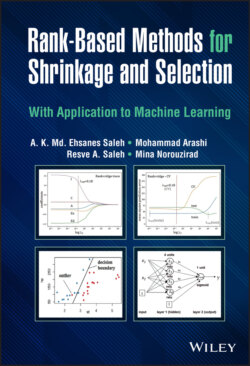Читать книгу Rank-Based Methods for Shrinkage and Selection - A.K. Saleh Md.Ehsanes, A. K. Md. Ehsanes Saleh - Страница 11
List of Tables
Оглавление1.1 Comparison of mean and median on three data sets.
1.2 Examples comparing order and rank statistics.
1.3 Belgium telephone data set.
1.4 Comparison of LS and Theil estimations of Figures 1.1(a) and (d).
1.5 Walsh averages for the set {0.1, 1.2, 2.3, 3.4, 4.5, 5.0, 6.6, 7.7, 8.8, 9.9, 10.5}.
1.6 The individual terms that are summed in Dn(β) and Ln(β) for the telephone data set.
1.7 The terms that are summed in Dn(θ) and Ln(θ) for the telephone data set.
1.8 The LS and R estimations of slope and intercept for Figure 1.1 cases.
1.9 Interpretation of L1/L2 loss and penalty functions
2.1 Swiss fertility data set.
2.2 Swiss fertility data set definitions.
2.3 Swiss fertility estimates and standard errors for least squares (LS) and rank (R).
2.4 Swiss data subset ordering using | t.value |
2.5 Swiss data models with adjusted R2 values.
2.6 Estimates with outliers from diabetes data before standardization.
2.7 Estimates. MSE and MAE for the diabetes data
2.8 Enet estimates, training MSE and test MSE as a function of α for the diabetes data
3.1 The ADRE values of ridge for different values of Δ2
3.2 Maximum and minimum guaranteed ADRE of the preliminary test R-estimator for different values of α.
3.3 The ADRE values of the Saleh-type R-estimator for λmax*=2π and different Δ2
3.4 The ADRE values of the positive-rule Saleh-type R-estimator for λmax*=2π and different Δ2
3.5 The ADRE of all R-estimators for different Δ2
4.1 Table of (hypothetical) corn crop yield from six different fertilizers.
4.2 Table of p-values from pairwise comparisons of fertilizers.
8.1 The VIF values of the diabetes data set.
8.2 Estimations for the diabetes data*. (The numbers in parentheses are the corresponding standard errors).
11.1 LLR algorithm.
11.2 RLR algorithm.
11.3 Car data set.
11.4 Ridge accuracy vs. λ2 with n = 337 (six outliers).
11.5 RLR-LASSO estimates vs. λ1 with number of correct predictions.
11.6 Sample of Titanic training data.
11.7 Specifications for the Titanic data set.
11.8 Number of actual data entries in each column.
11.9 Cross-tabulation of survivors based on sex.
11.10 Cross-tabulation using Embarked for the Titanic data set.
11.11 Sample of Titanic numerical training data.
11.12 Number of correct predictions for Titanic training and test sets.
11.13 Train/test set accuracy for LLR-ridge. Optimal value at (*).
11.14 Train/test set accuracy for RLR-ridge. Optimal value at (*).
11.15 Train/Test set accuracy for LLR-LASSO. Optimal value at (*).
11.16 Train/test set accuracy for RLR-LASSO. Optimal value at (*).
12.1 RNN-ridge algorithm.
12.2 Interpretation of the confusion matrix.
12.3 Confusion matrix for Titanic data sets using RLR (see Chapter 11).
12.4 Number of correct predictions (percentages) and AUROC of LNN-ridge.
12.5 Input (xij), output (yi) and predicted values p~(xi) for the image classification problem.
12.6 Confusion matrices for RNNs and LNNs (test size = 35).
12.7 Accuracy metrics for RNNs vs. LNNs (test size = 35).
12.8 Train/test set accuracy for LNNs. F1 score is associated with the test set.
12.9 Train/test set accuracy for RNNs. F1 score is associated with the test set.
12.10 Confusion matrices for RNNs and LNNs (test size = 700).
12.11 Accuracy metrics for RNNs vs. LNNs (test size = 700).
12.12 MNIST training with 0 outliers.
12.13 MNIST training with 90 outliers.
12.14 MNIST training with 180 outliers.
12.15 MNIST training with 270 outliers.
12.16 Table of responses and probability outputs.
